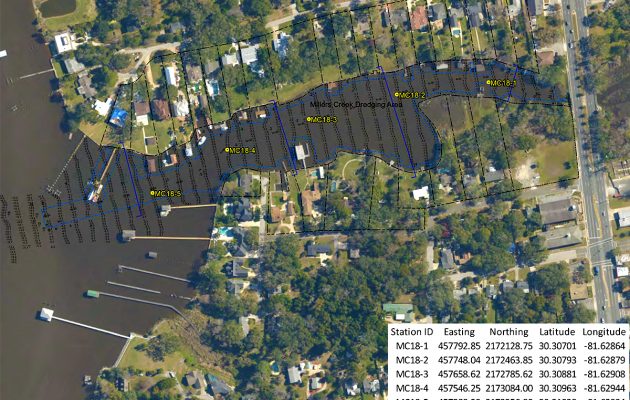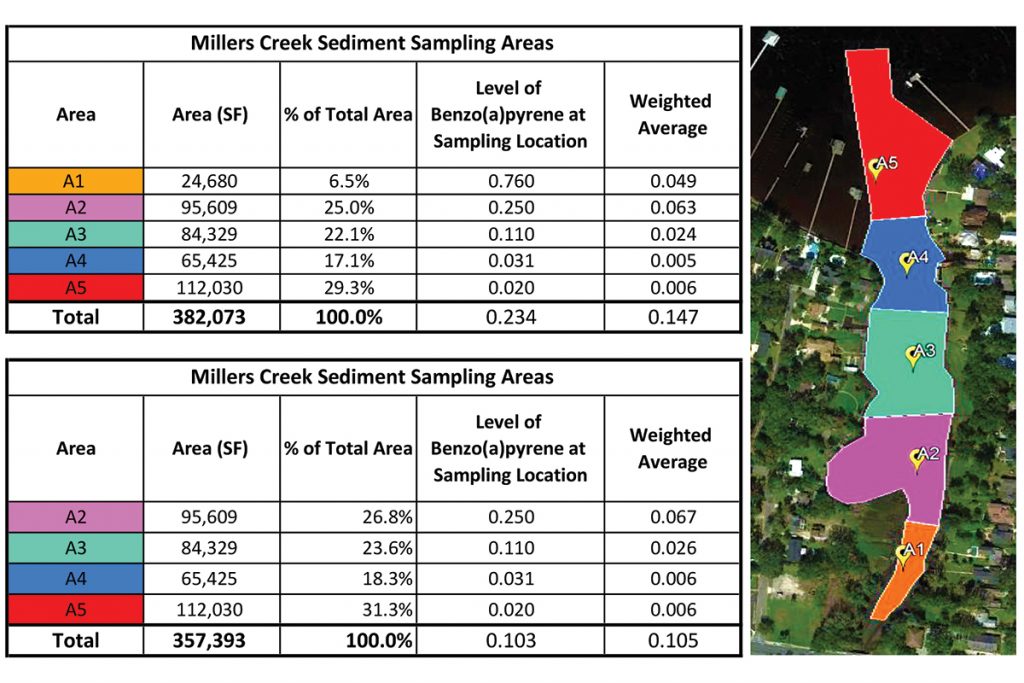Two issues could halt Millers Creek dredging project
Posted on August 2, 2018 By Editor Articles, Neighborhood News, Top Stories

After discussing two issues that could potentially shut down its dredging project before it gets started, the Millers Creek Special Tax District Board of Directors unanimously voted to set its yearly assessment at $3,000 per parcel during it meeting at Havana Jax Café in St. Nicholas July 23.
During the meeting, no residents spoke against the $3,000 assessment, which is the maximum amount allowed by city ordinance. After the vote, Nicole Spradley, District 5 Councilwoman Lori Boyer’s assistant, shared the good news that Boyer had placed a line item in the Mayor’s proposed budget allowing the city to match 12.5 percent of the funds spent by the special tax district on the Millers Creek dredging project. “The line item is in there, but as of now the budget has not been approved,” Spradley explained.
During the meeting the board discussed two issues that might be problematic toward the success of the dredging project.
The first, a financial issue, was mentioned by Spradley in Boyer’s stead. The Office of the Auditor General of the State of Florida had alerted the City of Jacksonville that Millers Creek Special Tax District has neglected to send it an audit report for the fiscal year 2016-2017. The auditor general requested a response by August 3, 2018, she said. “This is serious because if you don’t get it in to them, they can shut you down,” said Spradley.
The second issue concerns the requirements set by the Florida Department of Environmental Protection. One chemical sample in a small area of Millers Creek tested slightly more elevated than FDEP requirements, and the FDEP may want both the sediment and the water coming out of the sediment treated, “shutting the project down in its tracks,” said Senior Dredging Engineer Joseph Wagner of Wood Environment and Infrastructure Solutions, Inc. Wagner has been hired to oversee soil testing in the creek for the district.
Tardy audit
The issue about the tardy audit came as no surprise to the board. The Florida Auditor General had also sent a notice July 23 to Millers Creek Board Attorney Wayne Flowers of Lewis, Longman & Walker, PA., which he then forwarded to Board Chairman Sharon Johnson and Board Treasurer Jonathan Wright, who did not attend the meeting.
Robert M. Thaggard, CPA, will have the audit finished and sent to the state in September, said Johnson. Once the late audit is done, he will begin to work on the audit for the 2017-2018 fiscal year, she said.
Johnson said the delay may have been caused by confusion when Wright took over as treasurer for Christopher Rose, who stepped down from that position after the unexpected death of his wife, Teresa, in February 2018.
She also mentioned there had been a delay in finding an auditor whose fee was “affordable” and there may have been a misunderstanding among the board members about how long it would take to have a CPA finish the audit. No audit was due during fiscal year 2015-2016, because the district had not yet acquired any tax funding, she said, also noting the City does not require an annual audit.
“We’ve got to take these things very seriously. I’m not sure how this happened, but I believe it was a combination of things, and I take as much responsibility as anyone here about it,” Johnson said after informing the board she had spoken to several accountants more than two years ago, all of which stressed it takes several months to do an audit. Although she had passed their names on to the board at that time, “this somehow slipped through,” she said.
Creek testing and analysis
With one exception, there was lots of good news to report concerning the Millers Creek sampling and analysis plan, said Wagner, who has presented his findings to the FDEP and the U.S. Army Corps of Engineers (USACE).
Testing took place on June 13 and was divided into five areas, he said, adding that each sample was taken at a depth of 12 feet, two feet below the level the district intends to dredge the creek. “The idea is that you would dredge to 10 feet and while you were out there you would dredge the additional two feet as premaintenance. As it fills in, it will fill in the extra depth that you don’t necessarily need before it gets to the depth you want to operate. If you just dredge to the depth you want, the minute you stop dredging, it becomes higher than you want,” he said.
Another benefit to dredging at a lower level is that the sediment is “sandier” and most likely will not have any “analytes” of concern, he said. “This will give you a better picture of the whole water body, and when the permit is in place, you are not mandated to dredge down to that depth but can go to whatever level you can afford.”
It was also good news that the tests for metals, pesticides, and PCBs came in below the amounts the FDEP requires for disposal in residential areas, Wagner said. The only problem within the findings came from the level of benzo(a)pyrene, an oil-based hydrocarbon, on the dry weight PAH chart he had distributed.
The level of benzo(a)pyrene was .76, six-hundredths above the level of .7 required for disposal in a commercial/industrial site and .66 more than the required .1 for a residential site. The aberration occurred in Section A1, a small area of the creek closest to the Atlantic Boulevard bridge and comprises 6.5 percent of the amount of sediment to be dredged, he said.
The levels of benzo(a)pyrene in two other areas of the creek were .25 and .11 respectively, slightly higher than what can be disposed of in a residential area, but far below that which could be distributed in a commercial/ industrial area, he said.
Because the level of benzo(a)pyrene in one small area of the section was higher than required for commercial/industrial disposal, as it stands now, it would have to be disposed of in a landfill, which is more expensive because the district would need to pay a tipping fee, he said.
“The soil target clean-up levels are not magic. Saying something is toxic at .1 and suddenly not toxic at .09, that’s not the way these things work. These are arranged by grade, and the agencies have to look at how you are planning to handle the material to determine if what you are finally going to do with it causes a concern,” Wagner said.
Currently the FDEP has said it wants the one benzo(a)pyrene sample that came in above the commercial/industrial disposal requirement to be handled separately, possibly causing a halt to the entire project, said Wagner.
“Not only do they want us to take that material and handle it separately, they also want us to handle the water that would come out of that material and treat it before it goes back into the same creek it came out of. That is a no-go. That would stop this job in its tracks,” he said, adding that in his career he has never seen FDEP require special treating of the water from sediment.
Wagner said his suggestion to the agencies for the two areas that came within commercial/industrial standards but above residential is mix them with the areas that were well below the residential standards, so sample averages will come in below the disposal standards for residential.
Meanwhile, his suggestion for the area that came in above the commercial/industrial requirement is different. “We would test the samples and then test the water that comes out of those samples to see if any of this material is found in the water. Our argument would be if that water does not exceed their standards, there should be no argument that we would have to treat it special,” he said. “We don’t expect to have to do that. The stuff we are talking about binds to soils and is related to the road – it’s road hash. I’m arguing that we’re trying to restore the creek back to where it should be, and all I am asking of them is to give me some standards that I can work with.”
The cost to retest the one area is $14,700, Wagner said, noting the district could delay paying for the additional testing until it receives its dredging permits. “You could go through the process to see what your costs would be so at least you are not spending any more money on testing,” he said.
Wagner said he has requested that FDEP allow the sediment from the other four areas to be disposed of as residential, and that one area be retested and possibly be put in a landfill if it comes in higher than the commercial/industrial requirement. “It’s only six percent of the whole 53,000 cubic yards dredged,” he said.
Both Boyer and Dr. Quinton White, executive director of the Marine Science Research Institute at Jacksonville University, have written letters to the agencies in support of the Millers Creek dredging project, Wagner said. The agencies “respond really well” when they see support from prominent members of the community, he said.

Chart of the Millers Creek sampling areas as presented by Joseph Wagner of Wood Environment and Infrastructure Solutions, Inc. July 23.
By Marcia Hodgson
Resident Community News




 (No Ratings Yet)
(No Ratings Yet)





